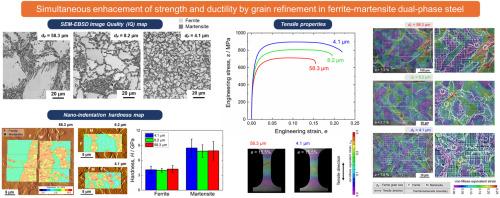Grain refinement of dual phase steel maximizes deformation ability of martensite, leading to simultaneous enhancement of strength and ductility
IF 9.3
1区 材料科学
Q1 MATERIALS SCIENCE, MULTIDISCIPLINARY
引用次数: 0
Abstract
Dual-phase (DP) steel, composed of soft ferrite and hard martensite, is well-known advanced high-strength steel (AHSS) because of its exceptional strength-ductility balance and low manufacturing cost. The present study found that microstructural refinement of DP steel enhanced not only its yield strength but also strain-hardening, leading to increasing both strength and ductility. Digital image correlation (DIC) analysis showed that strains were localized much more in soft ferrite than in hard martensite but the refinement of DP structure decreased the difference in average strains of ferrite and martensite, which avoided crack initiation in ferrite and led to large ductility. Consequently, the refinement of DP structure induced more plastic deformation in martensite through enhanced deformation constraints by the increase in ferrite/martensite interfaces. In-situ neutron diffraction experiment during tensile deformation quantitatively showed that higher phase stress was borne in hard martensite than in soft ferrite and microstructure refinement made martensite bear higher phase stress through the enhanced deformation constraint. Using strain/stress-partitioning results obtained by μ-DIC and in-situ neutron diffraction, individual stress-strain curves of ferrite and martensite could be successfully constructed for the first time. Individual stress-strain curves of ferrite and martensite reasonably explained the strength-ductility synergy in the fine-grained DP structure in terms of deformation constraint between two phases. Microstructure refinement in DP structures enhanced deformation constraint between two phases to maximize the deformation ability of martensite. The insight obtained in the present study could be applied to general heterostructured materials composed of soft and hard domains for overcoming the strength-ductility trade-off relationship.


双相钢的晶粒细化使马氏体的变形能力最大化,同时提高了强度和延展性
双相钢是一种由软铁素体和硬马氏体组成的高强度钢,因其优异的强度-塑性平衡和较低的制造成本而被誉为先进的高强度钢。本研究发现,DP钢的微观组织细化不仅提高了屈服强度,而且提高了应变硬化,从而提高了强度和塑性。数字图像相关(DIC)分析表明,应变在软铁素体中的局部化程度远高于在硬马氏体中的局部化程度,但DP组织的细化减小了铁素体和马氏体平均应变的差异,避免了铁素体的裂纹萌生,从而获得了较大的延展性。因此,DP结构的细化通过铁素体/马氏体界面的增加增强变形约束,在马氏体中引起更多的塑性变形。原位中子衍射实验定量表明,硬马氏体比软铁素体承受更高的相应力,显微组织的细化通过形变约束的增强使马氏体承受更高的相应力。利用μ-DIC和原位中子衍射得到的应变/应力分配结果,首次成功构建了铁素体和马氏体的单独应力-应变曲线。铁素体和马氏体的单独应力-应变曲线从两相变形约束的角度合理地解释了细晶DP组织的强度-塑性协同效应。DP组织的细化增强了两相之间的变形约束,使马氏体的变形能力最大化。本研究结果可应用于一般由软、硬畴组成的异质结构材料,以克服强度-延性权衡关系。
本文章由计算机程序翻译,如有差异,请以英文原文为准。
求助全文
约1分钟内获得全文
求助全文
来源期刊

Acta Materialia
工程技术-材料科学:综合
CiteScore
16.10
自引率
8.50%
发文量
801
审稿时长
53 days
期刊介绍:
Acta Materialia serves as a platform for publishing full-length, original papers and commissioned overviews that contribute to a profound understanding of the correlation between the processing, structure, and properties of inorganic materials. The journal seeks papers with high impact potential or those that significantly propel the field forward. The scope includes the atomic and molecular arrangements, chemical and electronic structures, and microstructure of materials, focusing on their mechanical or functional behavior across all length scales, including nanostructures.
 求助内容:
求助内容: 应助结果提醒方式:
应助结果提醒方式:


